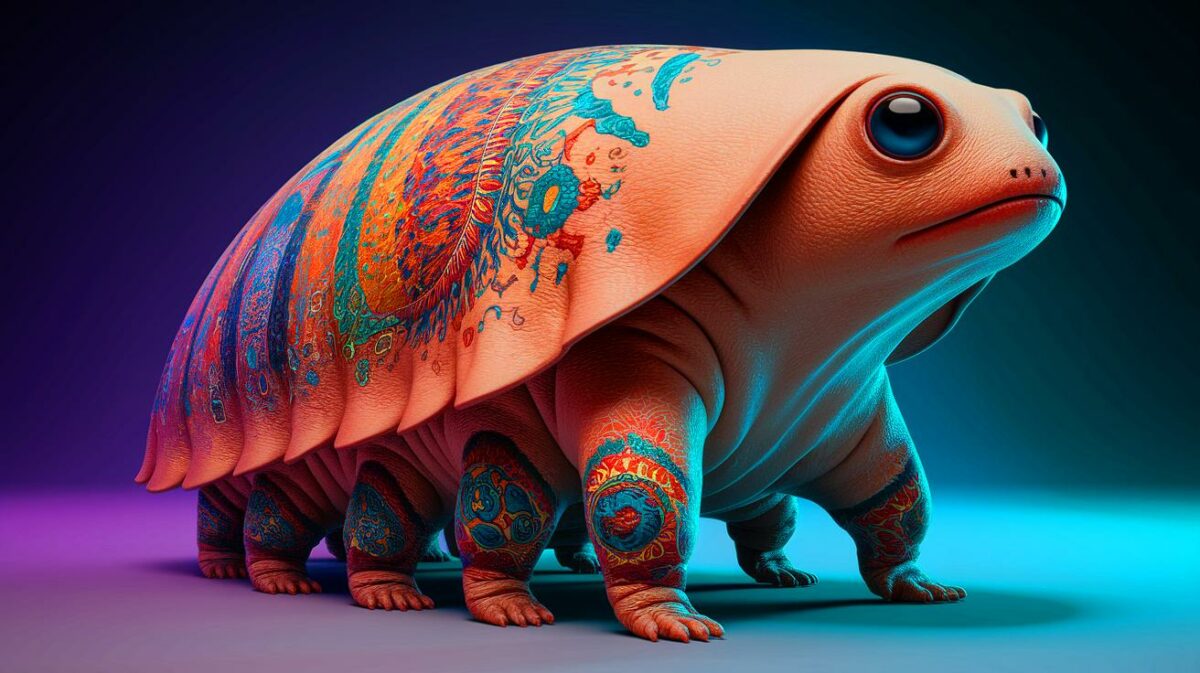| IN A NUTSHELL |
|
Tardigrades, commonly known as “water bears,” are capturing the attention of researchers worldwide due to their remarkable resilience and now, their new role in pioneering biological technology. These microscopic creatures, measuring just half a millimeter in length, are known for their ability to endure the most extreme environments. From the freezing temperatures of space to the crushing pressures of the deep ocean, tardigrades have survived conditions that would obliterate most life forms. Recently, scientists have begun experimenting with giving these resilient creatures “micro tattoos,” a fascinating process that involves etching tiny patterns onto their bodies using advanced microfabrication techniques.
Revolutionizing Microfabrication with Ice Lithography
In the ever-evolving field of microfabrication, the need for creating tiny, biologically compatible devices has become paramount. Researchers have taken a significant step forward by utilizing a groundbreaking technique known as ice lithography. This innovative process involves projecting an electron beam into a thin layer of ice that coats living tissue. As the ice evaporates, the pattern is left imprinted on the tissue, showcasing the potential for microfabrication in living systems.
The team embarked on this experiment by inducing a state of suspended animation in the tardigrades. By carefully drying them, the organisms were frozen to a chilling -226 degrees Fahrenheit and coated with a protective layer of anisole. This layer served as a canvas for the electron beam, which intricately etched patterns onto the tardigrades. As temperatures rose, the exposed anisole transformed into a biocompatible material, forming the micro tattoos. This process could potentially revolutionize medicine and bioengineering by ensuring safe and effective applications in living organisms.
The Resilience of Tattooed Tardigrades
Despite the complexity of the process, approximately 40% of the tardigrades survived the micro tattooing. This remarkable survival rate highlights the resilience and adaptability of these tiny creatures. Researchers are optimistic that with further refinements, the survival rate can be significantly improved. Interestingly, the tattooed tardigrades exhibited no discernible changes in behavior post-tattooing. Once rehydrated, they resumed their usual activities, seemingly unfazed by their new adornments.
This initial demonstration of the technique opens the door to exciting possibilities. Scientists envision a future where micro-electronics or sensors can be printed directly onto living tissue, heralding a new era of biomaterial devices and biophysical sensors. The intricate patterns, some as small as 72 nanometers, even included the university’s logo, showcasing the precision and potential of this technique.
Pioneering Advances in Living Electronics
The successful demonstration of ice lithography on tardigrades marks a pivotal moment in the development of living electronics. Researchers believe this technology could extend beyond tardigrades to various living organisms, including bacteria. Ding Zhao, a co-author of the study from Westlake University in China, emphasized the broader implications of this technology. By enabling the creation of micro-tattoos on various living organisms, the research sets the stage for future advancements in bioengineering.
Gavin King, the inventor of ice lithography, praised the study’s potential to transform science fiction into reality. The ability to pattern living matter could lead to the development of microbial cyborgs and revolutionize biomedical applications. As researchers continue to refine the technique, the possibilities for integrating microfabrication with living systems seem limitless.
Future Prospects for Tattooed Tardigrades
The findings of this study, published in the journal Nano Letters, represent just the beginning of the journey towards harnessing the power of microfabrication in living systems. Researchers are hopeful that the work with tattooed tardigrades will inspire further exploration and innovation. From creating microbial cyborgs to enhancing biomedical technologies, the potential applications are vast and varied.
As we look to the future, the question remains: How will these advancements in living electronics reshape our understanding of biology and technology? The journey of the tattooed tardigrades is just the first step in a thrilling exploration of the intersection between life and technology. What other incredible possibilities lie ahead?
Did you like it? 4.5/5 (27)










This is mind-blowing! Are we looking at the future of bioengineering? 🤯
That is absolutely a false AI generated image. That is not a tattooed tardigrade. That is a cartoon frog turtle. That doesn’t even look like a tardigrade
That image is not even remotely a tardigrade what is going on in this article and why did you pick that picture are you that lazy
Pretty disgusted that an AI image is being used and described as a photograph. If you legitimately care about sustainability and journalistic integrity, you should do better.
Wait, so they tattooed microscopic creatures? That’s insane. How do they even do that? 😮
40% survival rate? Poor little tardigrades, I hope they don’t suffer. 😢
How does this impact the tardigrades’ health and lifespan?
AI slop
I’m amazed by the resilience of these creatures. Truly fascinating!
Does anyone else find the idea of “living electronics” a bit unsettling?
Thank you for sharing this breakthrough! Excited to see where this leads. 🌟
Ice lithography sounds cool—no pun intended! ❄️
Can we apply this technology to other species, or is it just tardigrades? 🤔
How durable are these micro tattoos? Do they fade over time?
They killed 60% of them.
Such stupid scientists, or rather killers I should say!!
Isn’t this risking the natural balance of ecosystems?
I don’t know who captioned the leading image, but I’m calling BS.
Agreed 💯 – that’s the most AI thing I’ve ever seen
Geez, I can’t even get a regular tattoo without squirming! 😅
I’m curious about the ethical implications of this. What do others think?
Great article! The potential applications in medicine are thrilling.
What happens if these tattooed creatures are released into the wild?
Are there any long-term studies on the effects of these tattoos?
How can there be a long term study when this is a brand new thing???
What if we could use this technology on plants too? 🌱
I’m skeptical. This sounds like it could go wrong in so many ways.
Why tardigrades? Are they the only creatures that can survive this?
Thank you for such an informative piece! This is cutting-edge stuff.
Poor April fools joke, and even worse graphic as Tardigrades have four legs on each side.
Could these tattoos affect the creatures’ behavior or reproduction?
I’m all for innovation, but do we need to tattoo everything? 🤨
Dee dee dee dee dee dee dee. Dee dee dee dee dee dee dee. Dee dee dee dee dee dee dee
Wow, this is like the beginning of a superhero origin story! 🦸♂️
this is literally just Ai, tardigrades have 5 legs on each side, and they should have 4, I even think the article itslef its Ai, and btw this comments section its full of Ai too, 90% of them are bots
So, are we going to have tattooed bacteria next? 😆
This is a bit too much for my morning coffee read. Need to digest this. ☕
Fascinating! What are the next steps for this research?
What are the applications of this technology?
Can they tattoo my dog next? 😂
This sounds like science fiction. Are we making cyborg tardigrades now?
That picture is NOT a magnified view…….what in the AI-generated slop is this??
Wow, that is quite the AI garbage image. We want to see the actual tardigrade! Do better.
Agreed
That picture looks like some straight AI BS lmao 🤣
Please immediately correct the false caption on the AI generated “tardigrade” that is nothing like a tardigrade. You’re spreading misunderstanding.
What the heck?! Why would they label that trash AI-generated image as a magnified tattooed tardigrade? That’s a frog turtle Jason Momoa caterpillar. We all know it. Jeez. Ridiculous. Do better.
The image at the top says “magnified view” but you can literally tell all the “author” did was use an ai generator. 🤣
Don’t use ai slop you should know better
What’s with the garbage AI slop image?
“Magnified tattooed tardigrade”
Get out with that trash.
IF this article is even a semblance of being real, the very LEAST they could’ve done is show a REAL tardigrade instead of this AI trash. NO ONE wants to see a stupid collection of —stolen— mish-mashed artwork that claims to be ‘art’ on a headline. I hope whatever soulless hack allowed this has their comeuppance, downright shameful.